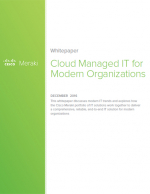Securing Your Network in the Age of Bring Your Own Device
This paper looks at the ever-increasing use of mobile devices, and why corporations must stay in tune with its consumerization, implementing a Bring Your Own Device policy to ensure the security of all parties involved - the employee and the corporation.
With the ever-increasing use of mobile devices, corporations must stay in tune with its consumerization, implementing a Bring Your Own Device (BYOD) policy to ensure the security of all parties involved - the employee and the corporation.
Corporations can net significant benefits from a BYOD program, taking into consideration critical factors like securing the appropriate network capability and boosting employee productivity.
With careful attention to the critical elements involved with a BYOD policy that secures success, corporations can come out on top, with increased sales revenue, workplace productivity and innovation leading the way.
Introduction/Overview
The Bring Your Own Device (BYOD) trend is becoming the norm in business practices today. Corporations employ BYOD policies to attract new recruits and make the business competitive in today’s increasingly mobile culture, motivated also by the cost-cutting perks that BYOD procures.
In part, the proliferation of mobile device use has quickly given the technology a swift influence in business. In 2012, “the U.S. wireless industry accounted for $33 billion in productivity improvements for U.S. businesses,” with gains of more than $1.4 trillion expected over the next decade. Further, the Wireless Association estimates 326.4 million wireless connections occurred in 2012 from devices like smartphones to tablets to feature phones.
Blurred Lines
The consumerization of technology has spurred the advancement of BYOD, instead of the previously common practice of businesses driving it, and consumers now expect the same easy access to and seamless integration of technology in the workplace as they do in their personal lives.
The August 2013 Forbes article “Why You Can’t Fight BYOD” aptly documents how mobile devices have become “part” of an individual, and as such, when people come to work, their mobile devices come with them. These devices “aren’t categorizable as tools, but instead are part of the employee.”
With the line between device and self-becoming blurred and the future development of products like smartwatches and Google Glass, more devices are sure to find their way into the workplace in the near future, prompting corporations to consider upgrading or implementing a BYOD policy.
Advancing With The Times
Employees desire more than just access to workplace emails and calendars, however. For BYOD to succeed, and for corporations to secure the benefits of implementing a wide-scale, comprehensive program, businesses must implement policies that accommodate anytime, anywhere access to key data and software, facilitate the sharing of information, and promote decision-making processes that allow employees to jump into the workflow 24/7.
Businesses that grab hold of BYOD - and address critical factors like access and security - will lay a foundation for future success. As evidence of its importance and the often complicated integration process, Forrester cites BYOD as one of the top issues facing IT today, among standouts like agility and cloud adoption. Interestingly, the Forrester report also reveals that a majority of respondents are either “currently implementing or have already implemented” a BYOD program - a statement that supports its widespread adoption by businesses across industries.
Preparing For the Future Now
In its brief history, the idea of Bring Your Own Device has quickly moved from being an idea born out of need. Today, the question of whether businesses need to accommodate BYOD is a foregone conclusion. Instead, corporations who don’t have a BYOD policy are scrambling to accommodate and secure the devices already accessing their networks. Still, others are in the position to move forward with an in-depth analysis of the concerns surrounding the implementation and security of a BYOD program.
It seems today’s most-pressing question stems from the need to develop a “clearly articulated position on BYOD, even if a business chooses not to allow for it,” according to Gartner’s “CIO’s Next-Generation Mobile Strategy Checklist.”
Benefits vs. Risks
The benefits of BYOD are clear for organizations that implement such a program. However, the risks are just as real. Companies that advance their BYOD policies with consideration of three integral facets ensure effective security measures - a significant concern - to protect sensitive corporate data and private employee information, a seamless implementation process, and net benefits from the program.
These facets include:
- Developing policies that address and balance the needs of employees and the business.
- Implementing programs that ensure availability of wireless networks for employees, while promoting effective scalability in the future.
- Securing solutions that appropriate security essentials and enablement.
What’s Related




Favorites





